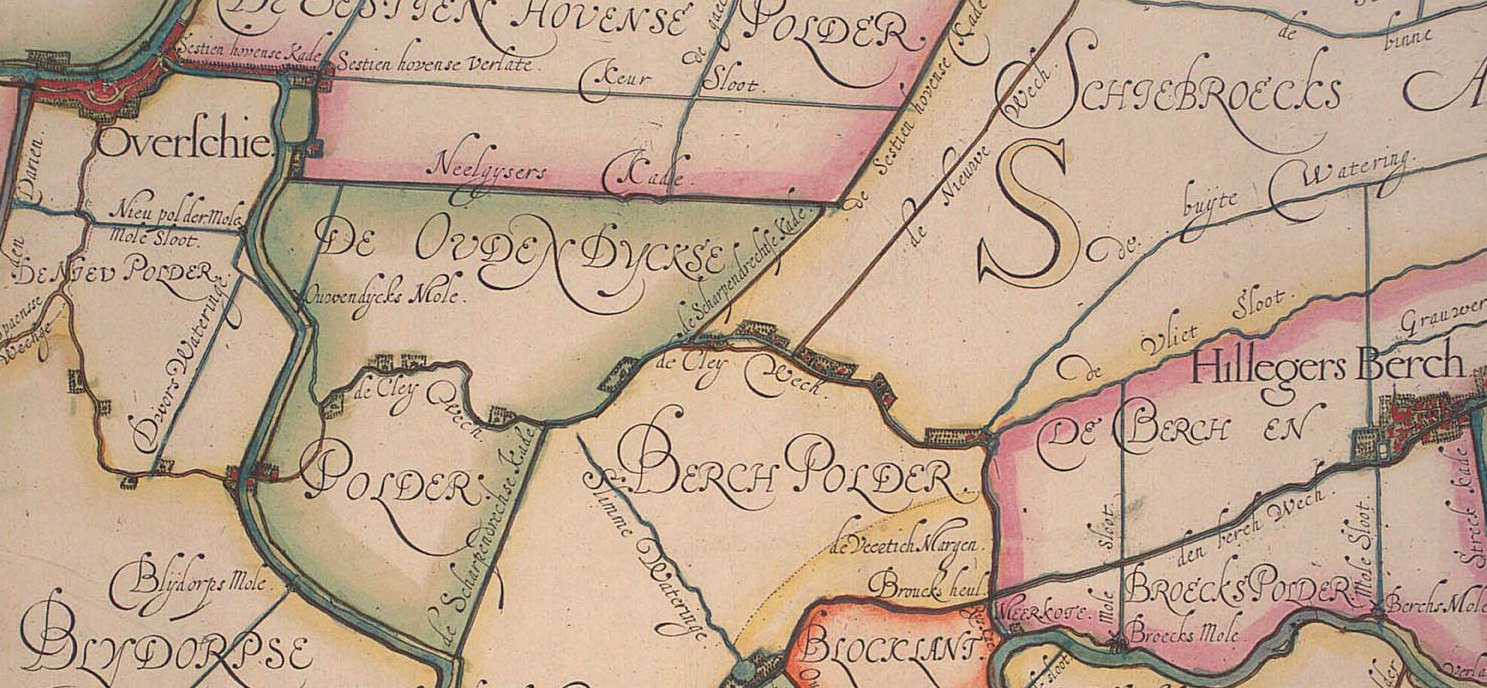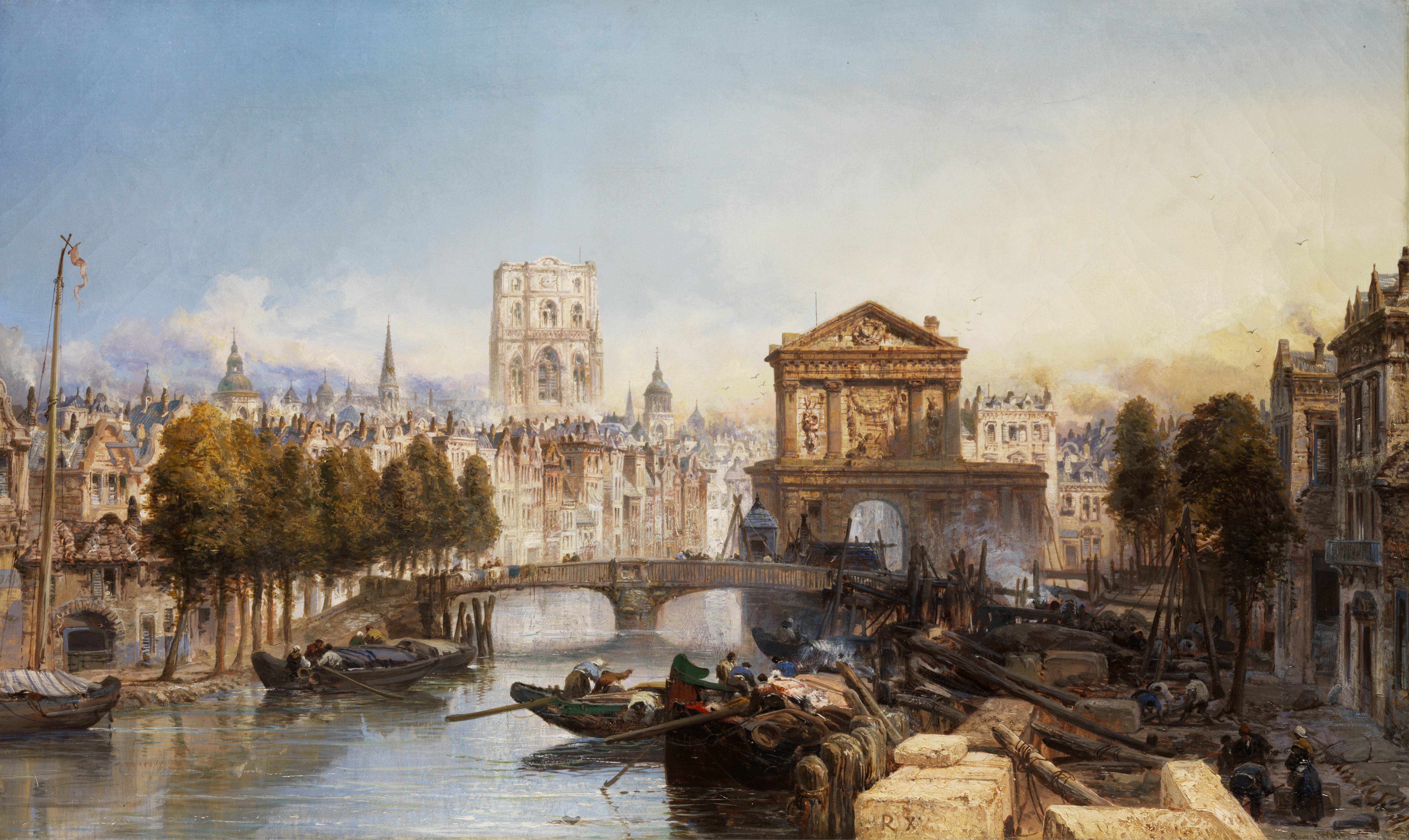|
Hillegersberg
Hillegersberg is a neighbourhood of Rotterdam, Netherlands. Primarily a green residential area with lakes, canals and parks, it was incorporated into the city of Rotterdam in 1941. History Hillegersberg was named after Hildegard van Vlaanderen, wife of Count Dirk II of Holland and West Friesland (920-988). The village was founded on a hill, form by a ridge of sand known locally as a donk or morre. Local flint finds here indicate pre-historic occupation and later discoveries of Roman pottery, medals as well as a bust of Emperor Hadrian show subsequent early activity in the area. According to legend, this ridge was formed by sand dropped from the apron of the mythical giant Hillegonda. She was said to have built her house on this ridge and so Hillegersberg, then known as Hillegonda's mountain, was named. The image of the giant Hillegonda with her torn apron is shown on Hillegersberg's coat of arms. A church and a castle, , were subsequently built on the ridge. The castle w ... [...More Info...] [...Related Items...] OR: [Wikipedia] [Google] [Baidu] |
Kleiwegkwartier
Kleiwegkwartier is a neighbourhood quarter in Rotterdam, Netherlands. It is in the southern part of Hillegersberg with origins dating from the early 1600s. Background The Kleiwegkwartier is located just north of the A20 autoroute and is part of Rotterdam's Hillegersberg-Schiebroek district. The district originally belonged to the municipalities of Hillegersberg and Schiebroek until they were annexed by Rotterdam in 1941. The area now makes part of Rotterdam's Hillegersberg-Zuid district. The area owes its name to the Kleiweg, the main road that runs centrally through its neighbourhood. The Kleiweg originally served as the main connection between Rotterdam and Overschie where it crossed old creek bridges over the Rivers Schie and Rotte. The road's early existence is documented on an area map dated 1611. Over time the road became increasingly lined by farms, houses and businesses—especially with major residential development occurring in the Kleiwegkwartier during the 1930s. ... [...More Info...] [...Related Items...] OR: [Wikipedia] [Google] [Baidu] |
Hillegersberg-Schiebroek
Hillegersberg-Schiebroek is a borough in northern Rotterdam. The borough has (on January 1, 2008) 40,846 inhabitants. Until the annexation by Rotterdam on August 1, 1941, Hillegersberg and Schiebroek were independent communities. In 1947 in Rotterdam, the first elected councils established, in 1948 was the first Hillegersberg-Schiebroek ward council. In 1972, the Regulation on the localities in the city of Rotterdam was adopted. The neighbourhood council of Hillegersberg-Schiebroek was in 1983 converted into a municipal section. Hillegersberg is operated by Rotterdam tram lines 4 and 8 and Schiebroek by tram line 25. The borough is also served by several bus lines from the RET and Qbuzz. Within the municipality Hillegersberg-Schiebroek the Stichting Wijkvervoer Hillegersberg-Schiebroek takes care of cheap transportation for the elderly and other people unable to use own or public transport. This is done under the name De Belbus.http://home.kpn.nl/~f2hbelbus/ Belbus The distri ... [...More Info...] [...Related Items...] OR: [Wikipedia] [Google] [Baidu] |
Rotterdam
Rotterdam ( , , , lit. ''The Dam on the River Rotte'') is the second largest city and municipality in the Netherlands. It is in the province of South Holland, part of the North Sea mouth of the Rhine–Meuse–Scheldt delta, via the ''"New Meuse"'' inland shipping channel, dug to connect to the Meuse first, but now to the Rhine instead. Rotterdam's history goes back to 1270, when a dam was constructed in the Rotte. In 1340, Rotterdam was granted city rights by William IV, Count of Holland. The Rotterdam–The Hague metropolitan area, with a population of approximately 2.7 million, is the 10th-largest in the European Union and the most populous in the country. A major logistic and economic centre, Rotterdam is Europe's largest seaport. In 2020, it had a population of 651,446 and is home to over 180 nationalities. Rotterdam is known for its university, riverside setting, lively cultural life, maritime heritage and modern architecture. The near-complete destruction ... [...More Info...] [...Related Items...] OR: [Wikipedia] [Google] [Baidu] |
Rotte (river)
The Rotte is a river in the Rhine-Meuse, Maas-delta in the Netherlands. The Rotte is the eponym of the city of Rotterdam: the city was founded in the 13th century when a dam was built along the river. Etymology The river was originally named Rotta, from ''rot,'' meaning "muddy" and ''aa'' meaning "water," thus "muddy water." Geography It rises in Moerkapelle in the so-called Groene Hart, Green Heart. It used to drain the Zuidplaspolder, Zuidplas lake until it was Land reclamation, reclaimed in 1840. It flows past Bleiswijk and Bergschenhoek; and then the village of Hillegersberg, which was built on a sand dune and was one of the few places in the marsh land that could be permanently settled before the dikes were constructed. In the churchyard there are the ruins of a 13th century castle whose origins probably date back to the Roman Empire. Originally it flowed into the Nieuwe Maas in Rotterdam; however, the lower reach of the river was dammed off and the water now flows to th ... [...More Info...] [...Related Items...] OR: [Wikipedia] [Google] [Baidu] |
Hook And Cod Wars
The Hook and Cod wars ( nl, Hoekse en Kabeljauwse twisten) comprise a series of wars and battles in the County of Holland between 1350 and 1490. Most of these wars were fought over the title of count of Holland, but some have argued that the underlying reason was because of the power struggle of the bourgeois in the cities against the ruling nobility. The Cod faction generally consisted of the more progressive cities of Holland. The Hook faction consisted for a large part of the conservative noblemen. The origin of the name "Cod" is uncertain, but is most likely a case of reappropriation. Perhaps it derives from the arms of Bavaria, that look like the scales of a fish. The ''Hook'' refers to the hooked stick that is used to catch cod. Another possible explanation is that as a cod grows it tends to eat more, growing even bigger and eating even more, thus encapsulating how the noblemen perhaps saw the expanding middle classes of the time. Aftermath of William IV's reign (13 ... [...More Info...] [...Related Items...] OR: [Wikipedia] [Google] [Baidu] |
Annexation
Annexation (Latin ''ad'', to, and ''nexus'', joining), in international law, is the forcible acquisition of one state's territory by another state, usually following military occupation of the territory. It is generally held to be an illegal act.: "Annexation means the forcible acquisition of territory by one State at the expense of another State. It is one of the principal modes of acquiring territory... in contrast to acquisition a) of terra nullius by means of effective occupation accompanied by the intent to appropriate the territory; b) by cession as a result of a treaty concluded between the States concerned (Treaties), or an act of adjudication, both followed by the effective peaceful transfer of territory; c) by means of prescription defined as the legitimization of a doubtful title to territory by passage of time and presumed acquiescence of the former sovereign; d) by accretion constituting the physical process by which new land is formed close to, or becomes attached to ... [...More Info...] [...Related Items...] OR: [Wikipedia] [Google] [Baidu] |
Controlled-access Highway
A controlled-access highway is a type of highway that has been designed for high-speed vehicular traffic, with all traffic flow—ingress and egress—regulated. Common English terms are freeway, motorway and expressway. Other similar terms include ''throughway'' and '' parkway''. Some of these may be limited-access highways, although this term can also refer to a class of highways with somewhat less isolation from other traffic. In countries following the Vienna convention, the motorway qualification implies that walking and parking are forbidden. A fully controlled-access highway provides an unhindered flow of traffic, with no traffic signals, intersections or property access. They are free of any at-grade crossings with other roads, railways, or pedestrian paths, which are instead carried by overpasses and underpasses. Entrances and exits to the highway are provided at interchanges by slip roads (ramps), which allow for speed changes between the highway and arterials ... [...More Info...] [...Related Items...] OR: [Wikipedia] [Google] [Baidu] |
Rotterdam The Hague Airport
Rotterdam The Hague Airport (formerly ''Rotterdam Airport'', ''Vliegveld Zestienhoven'' in Dutch language, Dutch), is a minor international airport serving Rotterdam, the Netherlands' second largest city, and The Hague, its administrative and royal capital. It is located north northwest of Rotterdam in South Holland and is the third busiest airport in the Netherlands. The airport handled over 2.1 million passengers in 2019 and features scheduled flights to European metropolitan and leisure destinations. It is also used extensively by general aviation and there are several flying clubs, a skydiving club and a flight training school located at the airport. History Early years After World War II, the Politics of the Netherlands, Dutch government decided that a second national airport was needed in addition to Amsterdam Airport Schiphol, Schiphol. Rotterdam had previously had an airport before the war; Waalhaven airport, but it was heavily damaged in the German bombing of Rotterd ... [...More Info...] [...Related Items...] OR: [Wikipedia] [Google] [Baidu] |
German Bombing Of Rotterdam
Rotterdam was subjected to heavy aerial bombardment by the ''Luftwaffe'' during the German invasion of the Netherlands in World War II. The objective was to support the German troops fighting in the city, break Dutch resistance and force the Dutch army to surrender. Bombing began at the outset of hostilities on 10 May and culminated with the destruction of the entire historic city centre on 14 May, an event sometimes referred to as the Rotterdam Blitz. According to an official list published in 2022 at least 1,150 people were killed (with 711 deaths in the 14 May bombing alone) and 85,000 more were left homeless. The psychological and physical success of the raid, from the German perspective, led the ''Oberkommando der Luftwaffe'' (OKL) to threaten to destroy the city of Utrecht if the Dutch command did not surrender. The Dutch surrendered in the late afternoon of 14 May, signing the capitulation early the next morning. Prelude The strategic location of the Netherlands between ... [...More Info...] [...Related Items...] OR: [Wikipedia] [Google] [Baidu] |




.jpg)
